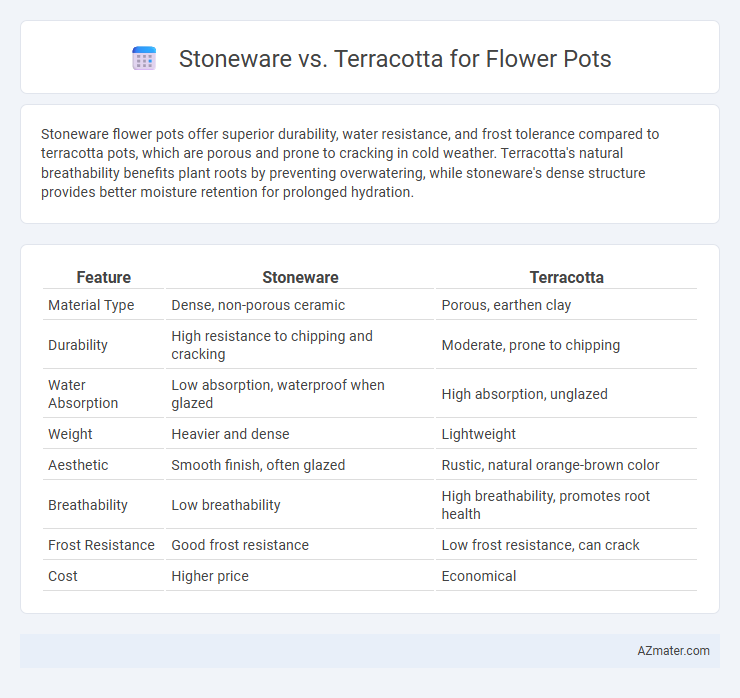Stoneware flower pots offer superior durability, water resistance, and frost tolerance compared to terracotta pots, which are porous and prone to cracking in cold weather. Terracotta's natural breathability benefits plant roots by preventing overwatering, while stoneware's dense structure provides better moisture retention for prolonged hydration.
Table of Comparison
| Feature | Stoneware | Terracotta |
|---|---|---|
| Material Type | Dense, non-porous ceramic | Porous, earthen clay |
| Durability | High resistance to chipping and cracking | Moderate, prone to chipping |
| Water Absorption | Low absorption, waterproof when glazed | High absorption, unglazed |
| Weight | Heavier and dense | Lightweight |
| Aesthetic | Smooth finish, often glazed | Rustic, natural orange-brown color |
| Breathability | Low breathability | High breathability, promotes root health |
| Frost Resistance | Good frost resistance | Low frost resistance, can crack |
| Cost | Higher price | Economical |
Introduction: Stoneware vs Terracotta Flower Pots
Stoneware flower pots offer durability and a glazed finish that resists moisture and weathering, making them ideal for long-term outdoor use. Terracotta pots, made from natural clay, provide excellent breathability and a classic, porous texture that promotes healthy root aeration. Choosing between stoneware and terracotta depends on factors like climate, plant type, and aesthetic preference.
What is Stoneware?
Stoneware is a dense, non-porous ceramic material fired at high temperatures between 1,100degC and 1,300degC, making it highly durable and resistant to moisture. Unlike terracotta, stoneware offers superior strength and frost resistance, making it ideal for long-lasting flower pots suitable for both indoor and outdoor use. Its impermeable surface helps prevent soil moisture loss and minimizes cracking, enhancing plant health and pot longevity.
What is Terracotta?
Terracotta is a porous, reddish-brown clay material commonly used for flower pots due to its excellent breathability and ability to regulate soil moisture. Its porous nature allows air and water to pass through, helping prevent root rot and promoting healthy plant growth. Terracotta pots are typically lightweight, affordable, and develop a natural, rustic look over time.
Durability: Comparing Stoneware and Terracotta Pots
Stoneware pots exhibit superior durability compared to terracotta due to their dense, non-porous ceramic composition that resists cracking and chipping under temperature fluctuations. Terracotta pots, made from porous clay, absorb moisture which can lead to brittleness and frost damage over time. This makes stoneware a more reliable choice for outdoor gardening and harsh climates.
Water Retention and Drainage Capabilities
Stoneware flower pots exhibit superior water retention due to their dense, non-porous structure that limits moisture evaporation, making them ideal for plants requiring consistent soil moisture. Terracotta pots, characterized by their porous clay composition, enable excellent drainage and aeration by allowing excess water to escape and moisture to evaporate quickly, reducing the risk of root rot. Choosing between stoneware and terracotta depends on the specific watering needs of the plant, with stoneware suited for water-loving plants and terracotta preferred for drought-tolerant species.
Aesthetics and Design Variety
Stoneware flower pots offer a refined aesthetic with smooth, often glazed finishes in diverse colors and patterns, enhancing indoor and outdoor spaces with contemporary or rustic charm. Terracotta pots provide a natural, earthy appeal with their characteristic reddish-brown hue and porous texture, supporting plant health through breathability and moisture regulation. Design variety in stoneware includes sleek modern shapes and intricate designs, while terracotta sticks to traditional, timeless forms that complement Mediterranean and vintage decor styles.
Suitability for Indoor vs Outdoor Use
Stoneware flower pots offer superior durability and weather resistance, making them highly suitable for both indoor and outdoor use, especially in climates with fluctuating temperatures and moisture. Terracotta pots provide excellent breathability and a porous nature, ideal for indoor plants but can crack and degrade when exposed to outdoor frost or heavy rainfall. Choosing between stoneware and terracotta depends on the environmental conditions and the plant's watering needs, with stoneware excelling in outdoor settings and terracotta preferred for controlled indoor environments.
Plant Health: Which is Better for Your Plants?
Stoneware flower pots offer superior moisture retention and durability, creating a stable environment that reduces the frequency of watering and promotes consistent root hydration. Terracotta pots are porous, allowing excellent air circulation and preventing root rot by enabling excess moisture to evaporate quickly, but they may dry out faster in hot climates. Choosing between stoneware and terracotta depends on your plant's specific water needs and the local climate, balancing moisture control with adequate aeration for optimal plant health.
Cost and Availability Analysis
Stoneware flower pots generally cost more than terracotta due to their denser material and firing process, offering superior durability and weather resistance. Terracotta pots are widely available and typically more affordable, favored for their porous nature that benefits plant aeration despite being more fragile. Both materials are common in garden centers, but terracotta's lower price and ease of production make it more accessible for budget-conscious gardeners.
Choosing the Right Pot: Stoneware or Terracotta?
Stoneware flower pots offer superior durability and water retention, making them ideal for plants that require consistent moisture levels. Terracotta pots, made from porous clay, provide excellent breathability and natural temperature regulation, which benefits drought-tolerant plants and succulents. Selecting between stoneware and terracotta depends on your plants' watering needs and the environmental conditions of your growing space.

Infographic: Stoneware vs Terracotta for Flower pot
 azmater.com
azmater.com